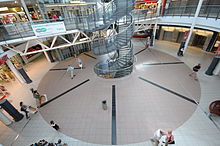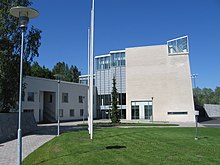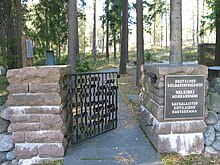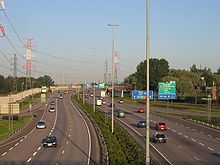Vantaa
| coat of arms | map |
|---|---|

|

|
| Basic data | |
| State : |
|
| Landscape : | Uusimaa |
| Administrative community : | Helsinki |
| Geographical location | 60 ° 18 ′ N , 25 ° 2 ′ E |
| Surface: | 240.36 km² |
| of which land area: | 238.38 km² |
| of which inland waterways: | 1.98 km² |
| Residents : | 228,166 (Dec. 31, 2018) |
| Population density : | 957.2 inhabitants / km² |
| Municipality number : | 092 |
| Postcodes : | 01002-01770 |
| Language (s) : | Finnish , Swedish |
| Website : | www.vantaa.fi |
Vantaa [ ˈvɑntɑː ] ( Swedish Vanda , until 1972 Finnish. Helsingin maalaiskunta , Swedish Helsinge landskommun , "rural municipality Helsinki") is the fourth largest city in Finland with 228,166 inhabitants (as of December 31, 2018) . It is located immediately north of the capital Helsinki and is part of the Helsinki agglomeration known as the “ Capital Region ”. The former rural community of Helsinki was first mentioned in 1428 and grew in the second half of the 20th century into a populous suburb of the neighboring city of Helsinki , which was separated from the rural community when it was founded in 1550. In 1974 Vantaa received city rights. The place is home to the Helsinki-Vantaa International Airport .
geography
Geographical location
Vantaa is located in the southern Finnish landscape of Uusimaa, not far from the coast of the Gulf of Finland . The neighboring cities and municipalities of Vantaa are Tuusula and Kerava in the north, Sipoo in the east, Helsinki in the south, Espoo in the west and Nurmijärvi in the north-west. The cities of Helsinki, Vantaa, Espoo and Kauniainen together form an agglomeration known as the “ Capital Region ”. In fact, they have now grown together into a single large city with around one million inhabitants, but the four cities are still politically independent.
Expansion of the urban area

Vantaa covers an area of 240.36 km². The urban area is quite flat and, by Finnish standards, has little inland water: only 1.98 km² is covered by water. The eponymous river Vantaanjoki flows through the west of the city, east Vantaa is traversed by its tributary Keravanjoki . There are only a few lakes in the urban area, and these are also rather small. The largest lake is the construction of the Päijänne tunnel scale Silvola Reservoir .
The dense development is mainly concentrated in the south and east of the urban area. The center of Vantaa is the Tikkurila district . Although Vantaa has now grown into a large city, parts of the city are still rural. In Vantaa there are forest areas of around 10,000 ha; thus around 40 percent of the urban area is forested. 4000 hectares (around 16 percent of the urban area) are used for agriculture.
City structure
Vantaa consists of the seven districts ( Finnish suuralue ) Myyrmäki , Kivistö , Aviapolis , Tikkurila , Koivukylä , Korso and Hakunila . These in turn are divided into a total of 61 districts (kaupunginosa) .
| Myyrmäki : | Askisto, Hämeenkylä, Hämevaara, Kaivoksela, Linnainen, Martinlaakso, Myyrmäki, Petikko, Vantaanlaakso, Vapaala, Varisto |
| Kivistö : | Keimola , Kiila , Kivistö , Lapinkylä, Luhtaanmäki, Myllymäki , Piispankylä, Riipilä, Seutula, Vestra |
| Aviapolis : | Lentokenttä, Pakkala , Tammisto , Veromies, Viinikkala, Ylästö |
| Tikkurila : | Hakkila, Helsingin pitäjän kirkonkylä, Hiekkaharju, Jokiniemi, Koivuhaka, Kuninkaala, Ruskeasanta, Simonkylä, Tikkurila , Viertola |
| Koivukylä : | Asola , Havukoski, Ilola , Koivukylä, Päiväkumpu, Rekola |
| Corso : | Jokivarsi, Korso , Leppäkorpi, Matari, Metsola , Mikkola , Nikinmäki , Vallinoja, Vierumäki |
| Hakunila : | Hakunila, Itä-Hakkila, Kuninkaanmäki, Länsimäki, Länsisalmi, Ojanko, Rajakylä, Sotunki, Vaarala |
history
The history of Vantaa goes back to the Middle Ages, even if the city has only had its current name since 1972. In Finnish, today's Vantaa was initially known as " Parish Helsinki" (Helsingin pitäjä) and from 1865 as " Rural Municipality Helsinki" (Helsingin maalaiskunta) , while in Swedish it was called Helsinge (in contrast to the city of Helsinki, Swedish Helsingfors ).
prehistory
In Vantaa traces of human settlement can be found up to the time of the Neolithic comb pottery culture around 5000 BC. Prove. At that time, a large part of today's Vantaa was still below sea level, it was only through the post-glacial uplift that it later became part of the mainland. The Stone Age population of the area made a living from fishing and seal hunting. In Vantaa an unusually large number of archaeological finds from the Comb Pottery period have been made.
Towards the end of the Iron Age , at the end of the first millennium AD, Vantaa was only sparsely and not permanently inhabited. Around the year 1000, settlers from Häme , who had previously used the area as hunting grounds, began to settle on the banks of the Vantaanjoki .
Swedish time
In the 12th century the landscape of Uusimaa (Swedish: Nyland ) came under Swedish rule. In the same or at the latest in the 13th century, settlers from the Swedish region of Hälsingland settled on Keravanjoki . The trade routes from Turku to Viborg and Hämeenlinna ran through the area , so that several prosperous villages developed. The name Helsingaa was first documented for the Vantaanjoki River in 1351 , when the Swedish King Magnus II granted the monks of the Estonian Padise Monastery the right to fish for salmon in the river. The river also gave its name to Helsinki parish , which was built at the end of the 14th century . The parish church village was conveniently located near the confluence of Vantaanjoki and Keravanjoki and at the crossroads of the trade routes from Turku to Viipuri and to Hämeenlinna and developed into one of the most important places in Uusimaa. The parish of Helsinki was first mentioned in a document in 1428. The stone-built St. Laurentius Church was built in the middle of the 15th century.
In 1550, King Gustav I Wasa founded the city of Helsinki ( Helsingfors in Swedish ) at the mouth of the Vantaanjoki as a rival port to Reval ( Tallinn ) on the other side of the Gulf of Finland. In 1640 Helsinki was moved to its current location on the Vironniemi peninsula. Even if the city remained relatively insignificant in the first centuries of its existence, from now on it put the parish of Helsinge in its shadow. In 1652 the parish of Helsinki was incorporated into the parish of the city of Helsinki.
From 1720 water-powered sawmills began to be built on Vantaanjoki. This made Helsinki parish one of the most important centers of early Finnish industry. At the beginning of the 19th century, after the founding of the Vanda Bruk ironworks , the ore deposits discovered in the area began to be developed. The rapids of the Vantaanjoki were harnessed for industrial production. An ironworks was built on the Vantaankoski rapids and a paint factory was built on the Tikkurilankoski rapids.
Russian time
As a result of the lost Russo-Swedish War , Sweden had to cede what is now Finland to Russia in 1809 . Three years later, Tsar Alexander I had the capital of the newly founded Grand Duchy of Finland relocated from Turku to Helsinki, which had hitherto been rather insignificant. While in 1805 the parish of Helsinki with its 4840 inhabitants was even larger than the city of Helsinki with 4337, it was overshadowed in the following period by the rapid growth of the new capital. In 1865 the parish had grown to 7,000 inhabitants, but 23,000 people lived in Helsinki.
In 1862 the first railway line in Finland between Helsinki and Hämeenlinna opened . For the settlements on the railway line like Tikkurila , this led to a surge in growth.
In 1865 Finland's local government was reformed. In place of the old parishes there were now political parishes . This made the Helsinki parish a rural municipality of Helsinki. Malmi was the administrative center of the rural community .
Since gaining independence
In the course of the 20th century, parts of the rural community were repeatedly incorporated into the city of Helsinki: in 1906 the districts of Meilahti , Käpylä and Kumpula , in 1912 Pasila , in 1926 Ruskeasuo and Uusipelto . In 1946 a large incorporation followed, in which Helsinki was added to a third of the area of the rural municipality. The Helsinki rural community lost its Malmi community center and two thirds of its population. In the 1950s, Tikkurila developed into the new center of the rural community. In 1954 and 1959, the rural municipality of Helsinki received areas from the municipalities of Tuusula and Kerava , while in 1966 Vuosaari was incorporated into the city of Helsinki.
In 1952, just in time for the Helsinki Olympic Games , Helsinki-Vantaa Airport opened . During the games, the marathon was also held in Vantaa . After the end of the Second World War, Vantaa began a rapid growth that continues to this day. New suburbs emerged, especially in the area of the railway lines. The first high-rise housing estates were built in the late 1950s. The rural exodus from the 1960s onwards accelerated growth. In 1970 alone, the population of the Helsinki rural community increased by 10,000. At the same time, the infrastructure in Vantaa was expanded: in 1962, construction work began on Ring Road III (Kehä III) , which surrounds Helsinki in a semicircle, and in 1975 the western parts of Vantaa were opened up with a new railway line.
In 1972 the rural community of Helsinki was raised to a market town and at the same time received its new name Vantaa after the river Vantaanjoki . Two years later the market towns were removed from the Finnish municipal code and Vantaa was converted into a town.
On October 11, 2002, a bomb attack occurred in the Myyrmanni shopping center , in which seven people were killed.
population
Population development and structure
As of December 31, 2018, Vantaa had 228,166 inhabitants. This makes Vantaa the fourth largest city in Finland after Helsinki, Espoo and Tampere . The population density is 957 inhabitants per square kilometer.
The population trend in Vantaa is rapidly increasing. While the rural community of Helsinki had around 6,200 inhabitants in 1870, the population had risen to 12,700 by the turn of the century. In 1940 there were already over 30,000 before the population halved due to the incorporation of large parts of the rural community in Helsinki in 1946. In the 1950s, however, the rural community of Helsinki experienced the greatest population growth, so that by 1960 it had 42,000 inhabitants again. The population continued to grow rapidly in the 1960s and 1970s, reaching 130,000 in 1980. Since then, the population curve has flattened; however, the population continues to grow by an average of around one percent per year.
19.1 percent of Vantaa's residents are younger than 16 years, 70.5 percent are between 16 and 64 years old and 10.4 percent are older than 64 years. This means that the population of Vantaa is younger than the national mean and also significantly younger than in Helsinki. The mobility of the population of Vantaa is high. Just over a quarter of the population in Vantaa was born there, another quarter comes from the other cities in the capital region.
| year | 1870 | 1880 | 1890 | 1900 | 1910 | 1920 | 1930 | 1940 | 1950 | 1960 | 1970 | 1980 | 1990 | 2000 | 2010 |
| Residents | 6.253 | 7,855 | 10.093 | 12,693 | 17,013 | 17,434 | 21,927 | 30,266 | 14,976 | 41,906 | 72.215 | 129,918 | 152.263 | 176.386 | 200.093 |
|---|
Languages and population groups
The coastal area of Uusimaa is historically part of the settlement area of the Finland Swedes . Vantaa, too, was originally Swedish : in 1910, 71 percent of the population in the rural municipality of Helsinki still spoke Swedish as their mother tongue. Although the number of Swedish speakers has actually increased in absolute terms, their share has fallen sharply due to the strong influx from other parts of the country: in 1960 they made up 10 percent of the population, in 1980 it was 5 percent, today only 3.1 percent of the inhabitants of Vantaa speak Swedish as a mother tongue. Despite the small percentage of the Swedish-speaking population, Vantaa is still officially bilingual with Finnish as the majority and Swedish as the minority language, because the absolute number of Swedish speakers is around 6000, above the 3000 inhabitant mark set in the Language Act.
The proportion of foreigners in Vantaa is rather high by Finnish standards. 4.6 percent of the population are foreign citizens; 6.2 percent were born outside of Finland. The largest groups of foreigners are made up of Russians , Estonians and Somalis .
religion
As in all of Finland, most of the residents of Vantaa are of the Evangelical Lutheran faith. 59.1 percent of the city's population belong to the Evangelical Lutheran Church of Finland . The Orthodox Church belong to 1.2 percent, 2.5 percent spread to other religious communities. 37.1 percent of Vantaa's residents are non-denominational.
There are seven Evangelical Lutheran parishes in Vantaa. The Finnish-speaking parishes of Hakunila, Hämeenkylä, Korso, Tikkurila, Rekola and Vantaankoski belong to the diocese of Helsinki , while the Swedish-speaking parish, which includes all of Vantaa, belongs to the diocese of Borgå . The city's Orthodox believers belong to the Helsinki parish, but have their own branch church in Vantaa, the Ascension Church. The Catholics belong to the Roman Catholic Diocese of Helsinki .
politics
|
City council
As in all Finnish cities, in Vantaa the city council (Finnish: kaupunginvaltuusto ) is the highest decision-making body on local matters. These include urban planning, schools, healthcare and public transport. The 67-member council is elected for four years. The 2017 local elections in Finland on April 9, 2017 for the electoral period from January 1, 2018 to December 31, 2021 (four years) led to the result shown in the table in Vantaa. The turnout was 52.3%.
Since the local elections in 2017, the strongest parliamentary group in Vantaa city council has been the Social Democrats , followed by the conservative rallying party . The Green Bund is also relatively well represented in Vantaa, with local election results of just under 18 percent, while the Center Party , one of the country's three major parties, is, like in most large cities, not of any major importance. Since the local elections in 2008, the Basic Finns , a right-wing populist party, have also been present on Vantaa's city council. The Left Alliance , the Christian Democrats and the Swedish People's Party are also represented .
administration
The city director (Finnish: kaupunginjohtaja ) of Vantaa is subordinate to the city council and is appointed by it. Its job is to manage the city's administration and budget. The social democrat Kari Nenonen has held this post since 2012.
coat of arms
The coat of arms of Vantaa was introduced in 1951, at that time still for the rural municipality of Helsinki. It shows the golden tail fin of a fish in the blue shield. The coat of arms is derived from the fact that in the past salmon were fished in large quantities in Vantaanjoki and the salmon is therefore a hallmark of the city.
Town twinning
Vantaa has the following partnerships:
|
|
Every year, Vantaa invites four young people from all partner cities to a one-week summer camp.
Economy and Infrastructure
traffic
Vantaa is well connected to Helsinki and has good transport links thanks to several motorways, railways and an international airport. Local public transport in Vantaa is operated by the regional transport association HSL .
Six of the capital's eight arterial roads lead through the urban area of Vantaa, namely the road to Vihti ( Vihdintie ) , the highways to Hämeenlinna ( Hämeenlinnanväylä ) , Tuusula ( Tuusulanväylä ) , Lahti ( Lahdenväylä ) and Porvoo ( Porvoonväylä ) eastern arterial road ( Itäväylä ) and the . These are connected by Ring Road III (Kehä III) , which surrounds Helsinki in a semicircle and largely runs through Vantaa.
Two railway lines departing from Helsinki cross Vantaa: The main line (Päärata) from Helsinki to Hämeenlinna runs through East Vantaa via the stations Tikkurila, Hiekkaharju, Koivukylä, Rekola and Korso. The line was opened in 1862 and contributed significantly to the development of Vantaa. The second railway line, the Vantaankoski Railway, ran until 2015 via the Myyrmäki, Louhela and Martinlaakso stations through West Vantaa to the Vantaankoski terminus. The section to Martinlaakso was completed in 1975, and in 1991 the line to Vantaankoski was extended. In the summer of 2015, a cross-connection called the Ringbahn (Kehärata) was opened from the Vantaankoski Railway via Helsinki-Vantaa Airport to the main line to Hiekkaharju. Both the main line and the ring line are served by local rail transport in the Helsinki region . Long-distance trains also stop at Tikkurila station, which is now Finland's second most important station.
The Helsinki Airport is located in the city of Vantaa. It was completed for the Helsinki Summer Olympics in 1952 . With around 13 million passengers a year, it is by far the largest commercial airport in Finland.
Culture and sights
Museums
The main attraction of Vantaa is the Heureka Science Center, which opened in 1989 . The facility, housed in a futuristic building in the Tikkurila district, is dedicated to providing scientific education. Visitors can carry out experiments themselves; there are also special exhibitions and an IMAX cinema, which is also used as a planetarium. Heureka has an average of almost 300,000 visitors per year.
The old Tikkurila station, built in 1862, is the oldest preserved station building in Finland and has housed the Vantaa City Museum since 1990. Here changing exhibitions, which deal mainly with the history of the city, are shown. The Finnish Aviation Museum is located directly at Vantaa Airport and has more than 70 aircraft on display.
The Art Museum of Vantaa is Mehrzweckhaus Myyrmäkitalo housed in the district Myyrmäki. There is also a library and an auditorium.
music

The Ankkarock Rock Festival has been taking place every August in the Korso district since 1989, and well-known Finnish and international rock bands regularly perform. In 2008 Ankkarock had 30,500 visitors, making it one of the largest festivals in Finland. The baroque music festival Vantaan Barokki is also held every summer .
In 1987 the Martinus concert hall was completed in the Martinlaakso district , where concerts, congresses and various cultural events take place. The Martinus Concert Hall is also the home stage of Vantaan viihdeorkesteri (Vantaa pops) , the only professional Finnish symphony orchestra that specializes in pop music .
Vantaa is home to bassist Raul Ruutu and guitarist Janne Kärkkäinen (both members of the rock band Sunrise Avenue ), rapper Cheek , rock musician and singer Jussi Selo ( Uniklubi ), pop and R&B singer Anna Abreu and who was founded in 2006 Rock band My First Band .
Personalities
sons and daughters of the town
|
|
Died in Vantaa
- Kalevi Kotkas (1913–1983), track and field athlete
- Ville Pessi (1902–1983), politician
Web links
Individual evidence
- ↑ Maanmittauslaitos (Finnish land surveying office): Suomen pinta-alat kunnittain January 1, 2010 (PDF; 199 kB)
- ↑ Statistical Office Finland: Table 11ra - Key figures on population by region, 1990-2018
- ↑ Website of the city of Vantaa: Metsätilat ( Memento of the original from February 23, 2007 in the Internet Archive ) Info: The archive link has been inserted automatically and has not yet been checked. Please check the original and archive link according to the instructions and then remove this notice. (Finnish)
- ↑ Website of the city of Vantaa: Maatilat ( Memento of the original from February 23, 2007 in the Internet Archive ) Info: The archive link was inserted automatically and has not yet been checked. Please check the original and archive link according to the instructions and then remove this notice. (Finnish)
- ↑ Statistical Office Finland: Table 11ra - Key figures on population by region, 1990-2018
- ↑ Tilastokeskus (Finnish Statistics Center): Vantaa (Finnish)
- ↑ a b c Website of the city of Vantaa: Syntyperäisiä vantaalaisia lähes kolmannes ( Memento of the original from November 11, 2007 in the Internet Archive ) Info: The archive link has been inserted automatically and has not yet been checked. Please check the original and archive link according to the instructions and then remove this notice. (Finnish)
- ↑ City of Vantaa: Vantaan väesto 2006/2007 , p. 6. ( Page no longer available , search in web archives ) Info: The link was automatically marked as defective. Please check the link according to the instructions and then remove this notice. (Finnish)
- ↑ John Westerholm: Kansa ja alue . In: Markku Löytönen, Laura Kolbe (Ed.): Suomi. Maa, kansa, kulttuurit , Helsinki 1999, here p. 285.
- ↑ City of Vantaa: Vantaan väesto 2016/2017 , p. 11. (Finnish)
- ^ Yleisradio (Finnish Public Radio), Vantaa election results , accessed on February 2, 2020
- ↑ Kuntavaalit 2017 - Vantaa
- ↑ Vantaa taskussa, information brochure of the city ( Finnish ), accessed on February 3, 2020
- ↑ Finavia (Finnish Aviation Authority) ( Memento of the original from June 19, 2008 in the Internet Archive ) Info: The archive link has been inserted automatically and has not yet been checked. Please check the original and archive link according to the instructions and then remove this notice.
- ↑ Heureka website ( Memento of the original dated February 6, 2007 in the Internet Archive ) Info: The archive link was inserted automatically and has not yet been checked. Please check the original and archive link according to the instructions and then remove this notice. (English)









